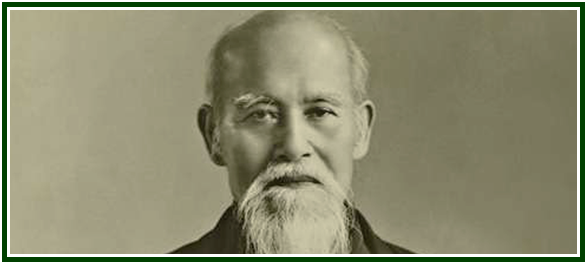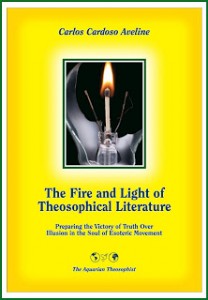
The Voice of Peace Can Often Resound Like
Thunder, Jolting Human Beings Out of Ignorance
Morihei Ueshiba

Morihei Ueshiba
0000000000000000000000000000000000000000000000
A 2016 Editorial Note:
We reproduce below a few Fragments from the book
“The Art of Peace”, by Morihei Ueshiba (1883-1969), who
founded the Aikido. The book was published by Shambhala
Publications, Inc., Boston & London, 1992, and has 126 pp.
We indicate the number of the page at the end of each quotation.
The inner identity of the philosophy of the Aikido with many
aspects of classical esoteric philosophy is easy to observe in these
axioms. A Master of the Wisdom wrote: “Strive, towards the Light,
all of you brave warriors for the Truth, but do not let selfishness
penetrate into your ranks”.[1] Military metaphors are frequent in
the spiritual tradition of nearly every nation: the Christian “New
Testament” and the Hindu “Bhagavad Gita” are two examples among
many. The aphorism 103, Chapter Eight of the “Dhammapada”, says:
“Better than a man who conquers in battles a thousand times a thousand
men is he who conquers himself. He indeed is the mightiest of warriors.”
Morihei Ueshiba teaches the same tenet of the universal wisdom.
(Carlos Cardoso Aveline)
0000000000000000000000000000000000000000000000000000000000000
* Foster and polish the warrior spirit while serving in the world; Illuminate the Path according to your inner light. (p. 46)
* The Path of Peace is exceedingly vast, reflecting the grand design of the hidden and manifest worlds. A warrior is a living shrine of the divine, one who serves that grand purpose. (p. 47)
* Your mind should be in harmony with the functioning of the universe; your body should be in tune with the movement of the universe; body and mind should be bound as one, unified with the activity of the universe. (p. 48)
* The Art of Peace is the principle of nonresistance. Because it is nonresistant, it is victorious from the beginning. Those with evil intentions or contentious thoughts are instantly vanquished. The Art of Peace is invincible because it contends with nothing. (p. 62)
* There are no contests in the Art of Peace. A true warrior is invincible because he or she contests with nothing. Defeat means to defeat the mind of contention that we harbor within. (p. 63)
* Transcend the realm of life and death, and then you will be able to make your way calmly and safely through any crisis that confronts you. (p. 85)
* Your heart is full of fertile seeds, waiting to sprout. Just as a lotus flower springs from the mire to bloom splendidly, the interaction of the cosmic breath causes the flower of the spirit to bloom and bear fruit in this world. (p. 30)
* Study the teachings of the pine tree, the bamboo, and the plum blossom. The pine is evergreen, firmly rooted, and venerable. The bamboo is strong, resilient, unbreakable. The plum blossom is hardy, fragrant, and elegant. (p. 31)
* Always keep your mind as bright and clear as the vast sky, the great ocean, and the highest peak, empty of all thoughts. Always keep your body filled with light and heat. Fill yourself with the power of wisdom and enlightenment. (p. 32)
* As soon as you concern yourself with the “good” and “bad” of your fellows, you create an opening in your heart for maliciousness to enter. Testing, competing with, and criticizing others weaken and defeat you. (p. 33)
* The Art of Peace is not easy. It is a fight to the finish, the slaying of evil desires and all falsehood within. On occasion the Voice of Peace resounds like thunder, jolting human beings out of their stupor. (p. 35)
* Be grateful even for hardship, setbacks, and bad people. Dealing with such obstacles is an essential part of training in the Art of Peace. (p. 86)
* The only cure for materialism is the cleansing of the six senses (eyes, ears, nose, tongue, body, and mind). If the senses are clogged, one’s perception is stifled. The more it is stifled, the more contaminated the senses become. This creates disorder in the world, and that is the greatest evil of all. Polish the heart, free the six senses and let them function without obstruction, and your entire body and soul will glow. (p. 40)
* All life is a manifestation of the spirit, the manifestation of love. And the Art of Peace is the purest form of that principle. A warrior is charged with bringing a halt to all contention and strife. Universal love functions in many forms; each manifestation should be allowed free expression. The Art of Peace is true democracy. (p. 41)
* If you perceive the true form of heaven and earth, you will be enlightened to your own true form. If you are enlightened about a certain principle, you can put it into practice. After each practical application, reflect on your efforts. (p. 108)
* The Art of Peace can be summed up like this: ‘True victory is self-victory; let that day arrive quickly!’ ‘True victory’ means unflinching courage; ‘self-victory’ symbolizes unflagging effort; and ‘let that day arrive quickly’ represents the glorious moment of triumph in the here and now. (p. 109)
NOTE:
[1] “Letters from the Masters of the Wisdom”, compiled by C. Jinarajadasa, TPH-Adyar, India, 1973 edition, first series, Letter 20, to Francesca Arundale, p. 52.
000
On the role of the esoteric movement in the ethical awakening of mankind during the 21st century, see the book “The Fire and Light of Theosophical Literature”, by Carlos Cardoso Aveline.

Published in 2013 by The Aquarian Theosophist, the volume has 255 pages and can be obtained through Amazon Books.
000